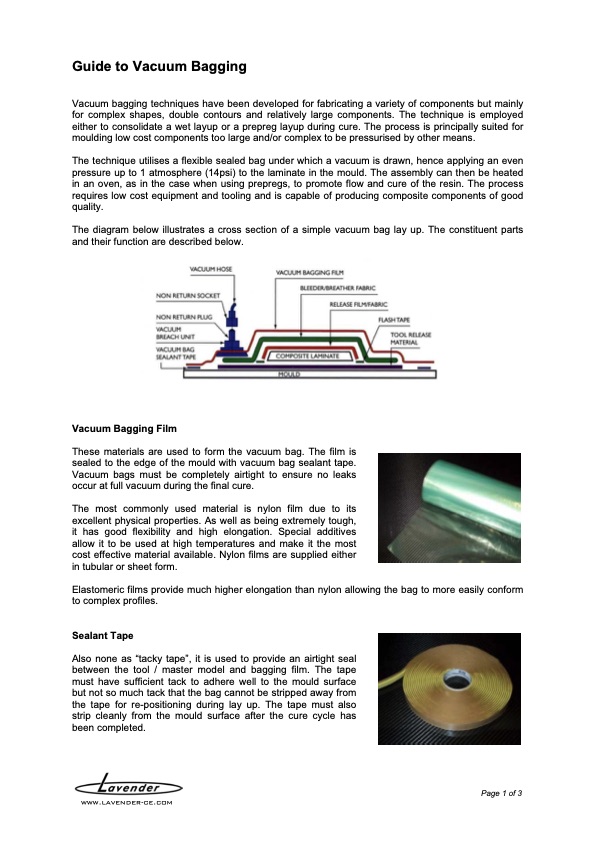
PDF Publication Title:
Text from PDF Page: 001
Guide to Vacuum Bagging Vacuum bagging techniques have been developed for fabricating a variety of components but mainly for complex shapes, double contours and relatively large components. The technique is employed either to consolidate a wet layup or a prepreg layup during cure. The process is principally suited for moulding low cost components too large and/or complex to be pressurised by other means. The technique utilises a flexible sealed bag under which a vacuum is drawn, hence applying an even pressure up to 1 atmosphere (14psi) to the laminate in the mould. The assembly can then be heated in an oven, as in the case when using prepregs, to promote flow and cure of the resin. The process requires low cost equipment and tooling and is capable of producing composite components of good quality. The diagram below illustrates a cross section of a simple vacuum bag lay up. The constituent parts and their function are described below. Vacuum Bagging Film These materials are used to form the vacuum bag. The film is sealed to the edge of the mould with vacuum bag sealant tape. Vacuum bags must be completely airtight to ensure no leaks occur at full vacuum during the final cure. The most commonly used material is nylon film due to its excellent physical properties. As well as being extremely tough, it has good flexibility and high elongation. Special additives allow it to be used at high temperatures and make it the most cost effective material available. Nylon films are supplied either in tubular or sheet form. Elastomeric films provide much higher elongation than nylon allowing the bag to more easily conform to complex profiles. Sealant Tape Also none as “tacky tape”, it is used to provide an airtight seal between the tool / master model and bagging film. The tape must have sufficient tack to adhere well to the mould surface but not so much tack that the bag cannot be stripped away from the tape for re-positioning during lay up. The tape must also strip cleanly from the mould surface after the cure cycle has been completed. www.lavender-ce.com Page 1 of 3PDF Image | Guide to Vacuum Bagging

PDF Search Title:
Guide to Vacuum BaggingOriginal File Name Searched:
guide-to-vacuum-bagging.pdfDIY PDF Search: Google It | Yahoo | Bing
5,000 BF Shipping Container Lumber Dry Kiln For Quality Lumber The 5,000 BF container kiln consists of one 40 foot high-cube aluminum shipping container... More Info
Shipping Container Lumber Dry Kilns by Global Energy Global Energy designed and developed the container kiln back in 1991. The purpose is to give access to portable sawmill owners, furniture makers, and small business the value added profit of dry kiln lumber and quality hardwoods... More Info
Vacuum Kiln Conversion Kit for Lumber and Wood Dry Kilns Convert your existing conventional dry kiln into a fast drying vacuum kiln. Similar to vacuum bagging in the boat building and aircraft industry, we have come up with a proprietary process which allows you to build a very simple vacuum kiln at a fraction of the price, and without the intensive conventional metal chamber structure... More Info
Vacuum Pump Cart System for Bagging Clamping Wood Drying and more Vacuum Cart with 2HP Pump and Dual Pistons with multiple multiplex vacuum ports and liquid reservoir... More Info
Vacuum Bagging Basics Vacuum bagging is a method of clamping, which has traditionally been used in the composites industry, but can also be used for vacuum drying materials, including wood products... More Info
| CONTACT TEL: 608-238-6001 Email: greg@globalmicroturbine.com | RSS | AMP |